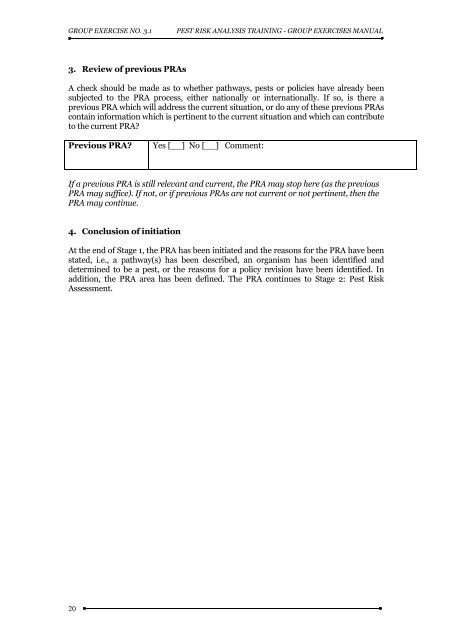PEST RISK ANALYSIS (PRA) TRAINING Group Exercises Manual
PEST RISK ANALYSIS (PRA) TRAINING Group Exercises Manual
PEST RISK ANALYSIS (PRA) TRAINING Group Exercises Manual
Create successful ePaper yourself
Turn your PDF publications into a flip-book with our unique Google optimized e-Paper software.
GROUP EXERCISE NO. 3.1<br />
<strong>PEST</strong> <strong>RISK</strong> <strong>ANALYSIS</strong> <strong>TRAINING</strong> - GROUP EXERCISES MANUAL<br />
3. Review of previous <strong>PRA</strong>s<br />
A check should be made as to whether pathways, pests or policies have already been<br />
subjected to the <strong>PRA</strong> process, either nationally or internationally. If so, is there a<br />
previous <strong>PRA</strong> which will address the current situation, or do any of these previous <strong>PRA</strong>s<br />
contain information which is pertinent to the current situation and which can contribute<br />
to the current <strong>PRA</strong>?<br />
Previous <strong>PRA</strong>?<br />
Yes [__] No [__] Comment:<br />
If a previous <strong>PRA</strong> is still relevant and current, the <strong>PRA</strong> may stop here (as the previous<br />
<strong>PRA</strong> may suffice). If not, or if previous <strong>PRA</strong>s are not current or not pertinent, then the<br />
<strong>PRA</strong> may continue.<br />
4. Conclusion of initiation<br />
At the end of Stage 1, the <strong>PRA</strong> has been initiated and the reasons for the <strong>PRA</strong> have been<br />
stated, i.e., a pathway(s) has been described, an organism has been identified and<br />
determined to be a pest, or the reasons for a policy revision have been identified. In<br />
addition, the <strong>PRA</strong> area has been defined. The <strong>PRA</strong> continues to Stage 2: Pest Risk<br />
Assessment.<br />
20













